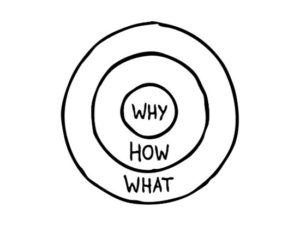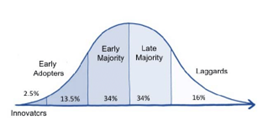In part 1 of our series, we talked about the significance of why for any high-performing law firm. Success is not about how phenomenal your lawyers are and the impressive list of clients. Rather, it’s about delivering value. For firm clients, value manifests, in large part, through the efficient and effective delivery of legal services and the near-elimination of nasty surprises. It means that your clients can rest easier knowing that your firm is looking out for their best interests.
For lawyers, value comes from making the highest and best use of their talent, being part of an exceptional group of colleagues, and taking pride in what they do. When values and beliefs comprise the why, your firm will be positioned for future viability, attracting excellent clients, retaining the most valuable employees, and pursuing new market opportunities.
The Golden Circle Inside Out
The golden circle is the what, how and why of your business. Traditional firms start with what. What do we do? We provide legal services. But Simon Sinek, author of the book “Start with Why: How Great Leaders Inspire Everyone to Take Action,” advises businesses to turn the golden circle inside out. That’s because for law firms and most other businesses, in fact, the what is remarkably…unremarkable. It doesn’t really matter how much you spit shine your unique selling proposition; your competitors also deliver high-quality legal services through a stellar group of lawyers in a collegial environment.

The Why Behind Apple
Apple isn’t the only company peddling (yawn) computer products. So, how did they become a household name? They started with why. Why is about what you believe and what you want your clients to notice about your firm. As mentioned, according to Sinek, Apple’s why is: “Everything we do, we believe in challenging the status quo.”
Of course, even when your marketing message starts with why, you’ll need a how. Apple’s how is delivering products that are beautifully designed, simple to operate, and user-friendly. The how may seem more straightforward when you’re selling computers and widgets. Your law firm, on the other hand, is a knowledge-based industry. Still, every law firm needs both a compelling why and a supporting how.
Let’s say your why includes challenging the status quo much like Apple did in the computer industry and the ALSPs are doing in the legal industry right now. In order to challenge the status quo, your firm is going to have to set the legal industry paradigm on its head. Simply put, that means finding more efficient and effective ways to work, the how of the golden circle.
That’s what legal project management does. Consequently, the uptake of LPM is rapidly accelerating. Yet, many firms have not even begun to tap into its true power.
Sinek provides an explanation of why this happens and, perhaps, a solution for law firms.
The Law of the Diffusion of Innovation
The diffusion of innovation is a term coined in 1962 by Everett Rogers, a communications professor, in a book by the same name. Most of us know it today as the innovation adoption curve, a bell-shaped distribution showing where the general population falls when it comes to adopting anything new. Just 2.5% of the population occupies the innovator category on the left edge of the curve and 13.5% are early adopters.
As you may recall from your university statistics class, roughly two-thirds of people are in the middle of the curve. They are neither rushing to adopt new technology (or new anything) nor are they ignoring it altogether.

Sinek says that upon introduction of a new product or technology, 10% of people will “just get it,” meaning that they are first in line to adopt something new. Think about it in terms of the introduction of LPM in your law firm or any other new process or technology. Ten percent is better than nothing, but it’s not a great conversion rate. It’s basically what you can expect to happen with little effort given that 16% of all people are innovators and early adopters.
Many firms get started with the early adopters, then turn their attention to the majority in the middle of the bell curve. To get widespread adoption, however, Sinek says you need to heap more love on the people that are inclined to adopt the technology in the first place.
Malcolm Gladwell published the tipping point theory in 2000, that inflection point where the minority view penetrates the masses. Sinek believes that you need 15% to 18% to start getting the attention of that cynical majority in the middle. That’s important to know when it comes to LPM.
How to Supercharge Your Initiative
Perhaps your LPM initiative is limping along with just a few early adopters and innovators. Or you are paralyzed by the 68% of people who aren’t willing to try something new not to mention the 16% who still own point-and-shoot cameras. Don’t waste time trying to convert those who will not facilitate the change.
Instead, focus your efforts on the innovators and early adopters. They are all-in because they want to be first. But that doesn’t mean your work is done. Find ways to give them ownership of the change and empower them to make it happen. They will be your biggest champions.
Position with Benefits, Not Features
There are plenty of examples of great ideas that failed to launch. LPM shouldn’t be one of them. Take a lesson from TiVo. The company’s greatest success is that (1) they produced a superior product and (2) the name TiVo, like Kleenex, is commonly used as a verb. By most accounts, however, they are a commercial failure.
Sinek says it is a positioning problem. They marketed the product as a machine that allows you to pause live television, skip commercials, and record your favorite shows. Plus, TiVo could memorize your viewing habits before you even asked. All great features, but the company led with the what. The result was that people either didn’t believe the claims or they were not impressed. Further, the promise of ‘memorizing your viewing habits’ sounded a little scary.
What happened? Even though we are TiVo’ing programs every day with inferior products, the company’s sales never reached the level anticipated and the stock price plummeted. What could they have done instead?
According to Sinek, they could have positioned TiVo for the type of person who likes to have total control of their life and wants to enjoy television on their own terms. “People will do the things that prove what they believe about the world and how they want others to see them,” he says.
When you put it like that, it’s not so difficult to understand how to position LPM for the innovators and early adopters in your firm. These are the people who will excite the majority and breathe momentum into your initiative. You don’t need huge numbers of converts to reach the tipping point. You do, however, need to target beyond the low-hanging fruit. That means engaging your innovators and early adopters.
In part 3, we’ll explore more about LPM and Sinek’s theories.
Posted In

